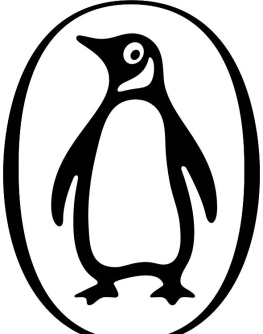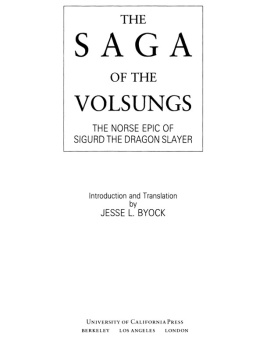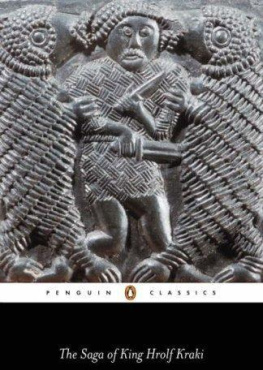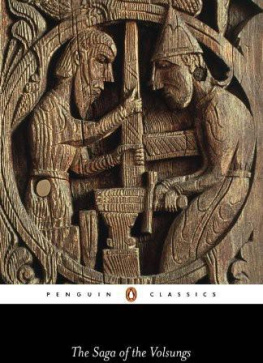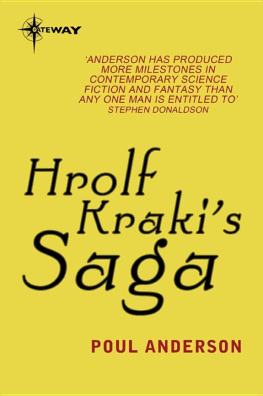JESSE L. BYOCK is Professor of Old Norse and Medieval Scandinavian at the University of California, Los Angeles, and a member of the UCLAs Institute of Archaeology. He has published numerous articles and books on Iceland and the Sagas, including Medieval Iceland: Society, Sagas and Power, Feud in the Icelandic Saga and a translation of The Saga of the Volsungs: The Norse Epic of Sigurd the Dragon Slayer. Professor Byock received his Ph.D. from Harvard University after studying in Iceland, Sweden and France. A specialist in North Atlantic and Viking studies, his work has been supported by grants from the National Endowment for the Humanities, the Fulbright Foundation and the John Simon Guggenheim Foundation.
THE SAGA OF KING HROLF KRAKI
Translated with an introduction by
JESSE L. BYOCK
PENGUIN BOOKS
PENGUIN BOOKS
Published by the Penguin Group
Penguin Books Ltd, 27 Wrights Lane, London W8 5TZ, England
Penguin Putnam Inc., 375 Hudson Street, New York, New York 10014, USA
Penguin Books Australia Ltd, Ringwood, Victoria, Australia
Penguin Books Canada Ltd, 10 Alcorn Avenue, Toronto, Ontario, Canada M4V 3B2
Penguin Books (NZ) Ltd, 182190 Wairau Road, Auckland 10, New Zealand
Penguin Books Ltd, Registered Offices: Harmondsworth, Middlesex, England
First published 1998
1 3 5 7 9 10 8 6 4 2
Copyright Jesse L. Byock, 1998
All rights reserved
The moral right of the translator has been asserted
Except in the United States of America, this book is sold subject
to the condition that it shall not, by way of trade or otherwise, be lent,
re-sold, hired out, or otherwise circulated without the publishers
prior consent in any form of binding or cover other than that in
which it is published and without a similar condition including this
condition being imposed on the subsequent purchaser
Contents
Introduction
The Saga of King Hrolf Kraki is one of the major Scandinavian legendary tales and belongs to the group of mythicheroic Icelandic stories known as the sagas of ancient times, or fornaldar sagas. These texts, which are also sometimes called the legendary sagas, are distinctive in that they tell of events that occurred, or are supposed to have occurred, long before the ninth-century settlement of Iceland. A narrative about pre-Viking Age kings and their rivals, Hrolfs Saga, as the text is often called, tells of King Hrolf, a warrior chieftain who ruled in Denmark in about the sixth century AD. Called Kraki (tall, angular and slender like a pole ladder), Hrolf was widely remembered in the medieval North as one of the most magnificent kings of ancient times, and the saga draws on a long oral tradition as it describes Hrolfs often treacherous family and recounts the exploits of his famous champions.
Hrolfs Saga, which was written in prose in fourteenth-century Iceland, has close affinities with the Old English verse epic Beowulf, written sometime in the period from the eighth to the early eleventh centuries. Both compositions draw on a common tradition of storytelling, recounting events that may or may not have occurred in the fifth-and/or sixth-century Danish kingdom of the Skjoldungs (Old English: Scyldinga). And both, though differentiated by centuries of independent transmission in different lands, have many of the same characters and settings. The relationship is based on an ancient core of shared storytelling, which displays the extent of a common oral tradition in the medieval North and may echo long-past historical events. Hrolfs Saga and Beowulf share a further similarity. Each provides information about a powerful champion whose bearlike character may reflect the distant memory of early cultic practices.
Medieval Iceland was a suitable place for passing down the memory of King Hrolf and his twelve champions. The settlement of Iceland, an island country first colonized by Norsemen in the ninth century, was an offshoot of Viking Age (c. 8001070) exploration and westward expansion across the North Atlantic. At considerable distance from Europe, Iceland was a frontier country. As in such communities elsewhere, the settlers and their descendants tended to venerate the traditions of the mother-culture. The Icelanders knowledge of the Scandinavian past was so broad that in medieval times they were acknowledged throughout the North to be master storytellers and the keepers of ancient poetic lore. The Danish historian Saxo Grammaticus, writing about 1200, credits the trustworthiness of Icelanders, who:
spend their time improving knowledge of others deeds, making up for their poverty by their intelligence. They take great pleasure in discovering and commemorating the achievements of all nations; in their view it is as enlightening to discourse on the prowess of others as to display their own.
In recounting their own past and the history of other peoples, Icelandic saga tellers made prose narration a high art. Their sagas were unusual among the literatures of medieval Europe where, with the exception of Ireland, traditional narrative stories were usually told in verse. The introduction in Iceland of the written saga in the twelfth century invigorated the process of narrative innovation. Writing provided Icelandic saga tellers with broader possibilities for reworking and preserving the lore of the past. In the case of the legends surrounding King Hrolf and his retinue of champions, the saga tellers had at their disposal an extensive body of existing heroic lore.
The various stories concerning Hrolf and his heroes were first assembled in a coherent, single text possibly as early as the thirteenth century. In its present form, Hrolfs Saga was composed around 1400. In 1461 a copy of a saga about Hrolf was included among the books in the Norse language in the library of the monastery of Modruvellir in northern Iceland. Today the earliest of the forty-four known manuscripts dates from the seventeenth century, and all of these are copies deriving ultimately from a single common ancestor. The saga author, well aware that he was arranging a compilation of older material, retains the episodic structure of his sources, often telling the audience when one sub-tale ends and another begins: Here ends the tale of Frodi and now begins the story of Hroar and Helgi, the sons of Halfdan.
If the underlying, individual episodes are often discernible, the saga is, nevertheless, a unified work, very much in the matter-of-fact style of the Icelandic family sagas. Even in the passages that treat fabulous events and creatures, the text uses an understated tone, relying on realistic-sounding description to create an almost believable story. So too the physical world of the saga is presented in non-fabulous geographical terms, and one can place most events on a modern map. Centred on the court at Hleidargard (Old Norse Hleidr, modern Danish Lejre) on the island of Sjaelland, the action spreads across the legendary landscape of northern Europe from Lapland in the far north to England in the west.
Because the saga, like many medieval tales, is fashioned from disparate parts, it is helpful to keep the basic structure in mind. The text falls into five main sections, each one focusing on a different set of characters. The common connection with Hrolf, the male and female members of his family, and his court unites the episodes, giving the saga a consistent narrative focus. The first section () gives the often modest Hrolf an illustrious pedigree. Opening with a dynastic conflict, the saga plunges into the struggle between King Halfdan and his brother Frodi, who were greatly dissimilar in character. At issue was control of the Danish kingdom. In this first part the saga teller uses the unfolding conflict to introduce Hrolfs tempestuous ancestors. These include the young princes; Helgi, Hrolfs father; Hroar, his uncle; and Signy, his aunt.



